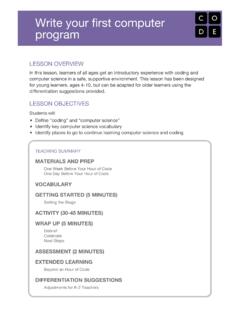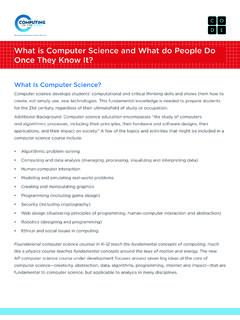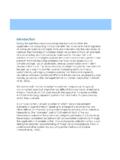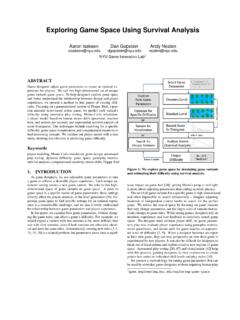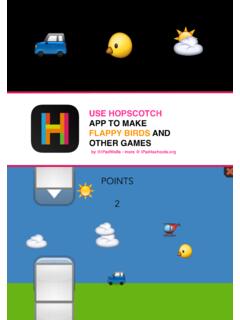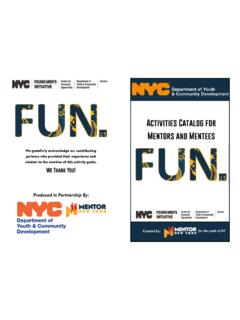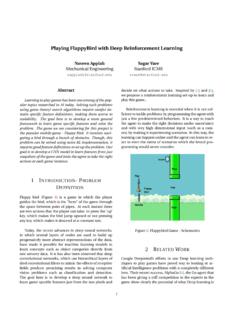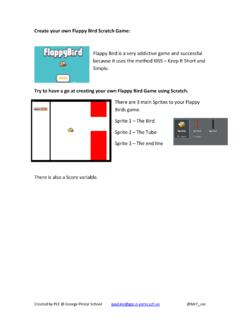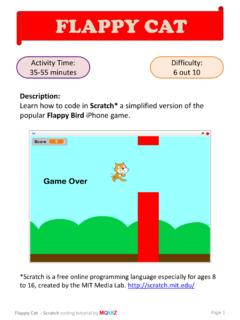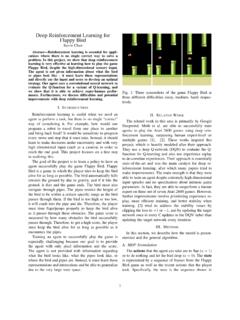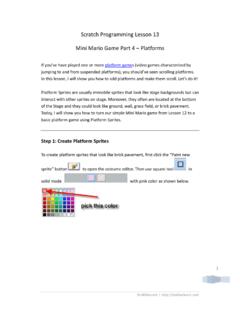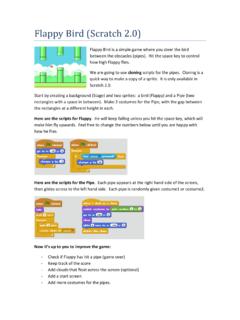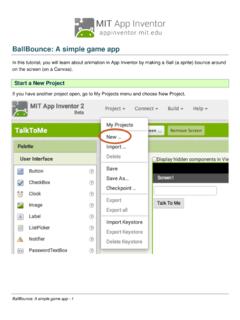Transcription of Make a Flappy game - Code.org
1 make a Flappy gameLESSON OVERVIEWIn this lesson, learners get an introductory experience with computer science andcreate a game using basic block lesson has been designed for learners inthe middle grades, ages 10-16, but can be adapted for younger or older learners usingthe differentiation suggestions OBJECTIVESS tudents will:Define coding and computer science Identify key computer science vocabularyMake connections between computer science concepts and the real worldIdentify places to go to continue learning computer science and codingTEACHING SUMMARYMATERIALS AND PREPOne Week Before Your Hour of CodeOne Day Before Your Hour of CodeVOCABULARYGETTING STARTED (5 MINUTES)Setting the StageACTIVITY (30-45 MINUTES)WRAP UP (5 MINUTES)DebriefCelebrateNext StepsASSESSMENT (2 MINUTES)Speak UpEXTENDED LEARNINGB eyond an Hour of CodeTEACHING GUIDEMATERIALS AND PREPOne Week Before Your Hour of CodeReview the Hour of code Educator Guide and Best Practices from SuccessfulEducators in order to begin to plan your Hour of code your Hour of code event if you d like to receive swag or and complete the online tutorial yourself: make a Flappy GameBe sure to test it first before asking your students to complete it.
2 Check yourtechnology and decide if you need to troubleshoot anything in advance of yourHour of Day Before Your Hour of CodeWrite the words coding , programming and debugging on the board or addthem to your word wall if you have student who completes the activity should receive a certificate. Print one foreveryone in advance to make this easier at the end of your Hour of - (v) to write code , or to write instructions for a - Finding and fixing problems in your algorithm or - An algorithm that has been coded into something that can be run by STARTED (5 MINUTES)Setting the StageWelcome students to class and very briefly introduce the day s : Today we re going to spend one hour learning to code . Has anyone here heardthe term code before? What does it mean? Students might mention that a code is like a secret message, or that it s related tocomputers in some that in computer science, code means a set of instructions that a computercan understand.
3 Let students know that today, they are going to practice coding, Teaching TipOne way to introduce the Hour of code if you are not very familiarwith coding yourself is to show one of our inspirational one you think your students will find inspiring, and share itnow. For young learners, we suggest Anybody Can Learn. programming and debugging .Define:Coding means to write code , or to write instructions for a , similarly, means to write code or instructions. Today, you willprogram with blocks on the computer (if you re using an online tutorial) or with penand paper (if you re using an unplugged activity).Debugging means to check code for mistakes and try to fix students to think about what their ideal next step might be after high schoolgraduation. Ask students to raise their hand if they believe that next step will requirethem to use a computer. Everyone should raise their hand, because computers are allaround our phones, in our cars, even in our microwaves and dishwashers!
4 Ask students to guess how many K12 schools there are in the United States ofAmerica. The answer is around 100,000. Now ask students to guess how many ofthose K12 schools offer a course in computer science. The answer is less than 1 in 4schools. That means that less than 25% of the US population has the opportunity tolearn computer science in school. Ask students: how does this impact a youngperson s ability to land their dream job or get into their ideal college, if they have littleto no experience with computers? And this problem exists not just in the US, but allover the that across the globe, young people just like your students are participating inHour of code as a way to bring awareness to this injustice the lack of access tocomputer science education. Your class will be taking part, not just to learn the basicsof CS and have a little fun but also to take a stand and use your voice to speak upabout the importance of CS for (30-45 MINUTES)Challenge your students to complete the make a Flappy Game on the age and ability of your students, you might consider:For middle and high school students, we suggest you choose tutorials that allowfree play and creation of apps or games .
5 You can have students work independentlyor in pairs or small groups. There are many other tutorials on thatallow for free creation, including Playlab and our new beta tool younger students, we suggest you break your class into pairs or very smallgroups (three to four students each) and ask each group to work together tocomplete the tutorial using pair adult learners, the Write your first computer program tutorial works extremelywell either as an independent challenge or a pair programming TipBe sure to play through your chosen tutorials yourself, before askingyour students to attempt them. That way you ll know what to expectand can make decisions about whether to let students choose theirown tutorial, or if you want to assign tutorials based on student a group or individual finishes early, they can attempt another tutorial by UP (5 MINUTES)DebriefFacilitate a Turn and Talk. Ask students to share their game, app or final productwith a friend for feedback.
6 Then switch and check out your partner s app or game. Aska few groups to share out their experience: what did you learn about how apps andgames work today? How do you feel having had the opportunity to study computerscience?CelebrateExplain that you are spending one hour coding today, because this week is CSEducation Week, and millions of other students across the globe have also beenlearning one Hour of code this week. Congratulate students on being part of this worldwide each student a certificate with his or her name on StepsLet students know that if they enjoyed today s activity, they have many options forcontinuing to code . Encourage students to visit for a list of options, or,if you re planning any of the extension activities that follow, tell students what s comingnext in your (2 MINUTES)Speak UpChallenge students to share some aspect of their Hour of code experience on socialmedia using #hourofcode as a way to lend their voices to this world wide can share their game, images, videos or just their LEARNINGB eyond an Hour of CodeAfter your Hour of code ends, there are many ways to continue teaching computerscience in your K-5 classroom.
7 Here are some ideas:Teach the code Studio Computer Science Fundamentals courses. These fourcourses are designed for young learners. Students work their way through a seriesof puzzles that teach them to code , and educators have access to engaging lessonplans that help make the learning coming alive. offers free professionaldevelopment for these courses, online or a computer science expert to talk to your class about his or her t know any local computer scientists? Try signing up for a virtual classroomvisit through s and Skype s Guest Speakers in Computer ALIGNMENTC ommon Core English Language Arts StandardsCommon Core Math StandardsCSTA K-12 Computer Science StandardsISTE Standards for Students
